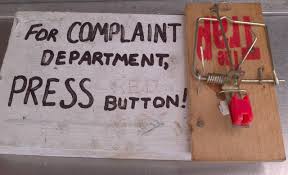 OK, so some business just pissed you off and wasted your time. You want to get this company’s attention and resolve the problem. However, you’ve found that this company sees you are just a $ sign — it has no great motivation to fix the problem. So what do you do?
OK, so some business just pissed you off and wasted your time. You want to get this company’s attention and resolve the problem. However, you’ve found that this company sees you are just a $ sign — it has no great motivation to fix the problem. So what do you do?
Oddly enough, the answer is not intuitive. The time-honored solution of sending a written complaint letter may no longer be very effective. However, the Internet has created some new tools that consumers can use to quickly and effectively resolve their complaints.
Use Social Media
Facebook, Instagram and Twitter are advertising outlets increasingly used by businesses to communicate with their customers. Enterprising consumers have also begun using these social media platforms to register complaints and get solutions to their problems. And the solutions tend to come far more quickly than by sending emails or snail-mail complaints.
Some Other Effective Tips
Be proactive. That means you should buy products or services through Amazon.com or some other Internet retailer that will stand behind your purchase and compel merchants to accept returns where the goods or services were not satisfactory. It is no coincidence that Amazon has become a force in retailing; it really does offer excellent customer support. Similarly, Costco also offers some very effective customer protections, including an excellent return policy.
Use a credit card (and NOT a debit card), where possible, for the purchase of a good or service. Credit card companies are obligated, by law, to refund your money and deal directly with any merchant that has not delivered on what it promised. The credit card companies enjoy leverage and professional intervenors who will take your fight to the company for you. They aren’t “consumer advocates” and will do as little as possible to resolve the matter, but because of their size, we’ve found that contesting a charge through a credit company is very effective.
Send a well-written demand letter. We recommend you write and send a complaint to the retailer and then post copies of your demand at a few of the sites listed below. An effective demand letter should be concise and clear. For example, it should address the following points:
- Do you want a refund….full or partial?
- Do you want an admission of error by the company or just a fix?
- Do you want to prevent the company from doing the same wrong to other customers?
Writing such letters requires precise, cool-headed engagement. Leave your anger, angst and strong emotions at the door; letters or e-mails should be written with a tone of professionalism and determination. When writing, consider that a judge or some other third party may read the letter. If you sound like a hot-head, they’ll perceive you as such. Keep focused on your objectives and do not allow the company to divert your objectives. Their “preserve the sale” defenses often include strategies to change your plans and add services or goods by touting “special deals”.
Post Your Demand Letter on Complaint Sites
We encourage you to use our battle-tested HIGHLY EFFECTIVE COMPLAINT LETTER FORM. It will provide you with a structure of how to present your arguments as well as some tips about how to get the right peoples’ attention. Then post your demand letter on some of the following websites:
Rip-Off Report – Is one of the longer-operating and most frequently used complaint websites on the Net. Its focus is largely upon getting your gripe out into the public. Allegedly, companies read the reports posted on Rip-Off Report and then will try to resolve the issue. We submitted our own “report”, but it didn’t elicit any response by Time Warner Cable.
Measured Up – Like Rip-Off Report, it is a gripe site that shares your experience with others. It is a well-designed and easy-to-use site. However, while it claims that it send your complaint directly to the company, because it doesn’t ask for account information it is unlikely that the company even knows your identity, let alone how to fix your problem.
Better Business Bureau – Where Rip-Off Report focuses upon sharing your rip-off experience with the public, the BBB (a long-time business-supported organization) is more oriented towards getting your complaint resolved. It views itself as an intermediary between you and the retailer. It is fairly good in ferreting out fly-by-night or unusually bad local businesses, but is largely ineffectual with the large national retailers. It is probably best to use the BBB only if you feel you’ve been scammed by a local company, if at all.
Get Human – Boasts most immediate access to company complaint departments. It offers phone numbers, emails and other contact information. It also makes it possible to post brief versions of your complaints on line so that others can see it. Overall, not bad, but not gangbusters.
Yelp – Like Angie’s List and the BBB, this is a fairly useful site for airing your complaints (or compliments) about a local company, but it is less useful for getting a problem resolved with a large national retailer. We love Yelp and use it a lot to find local restaurants or service providers.
Call Red – It is largely a referral service to various national retailers. It doesn’t disclose the nature or number of the complaints it has received to the public (even though its site suggests that it has a comparison feature). We weren’t impressed.
